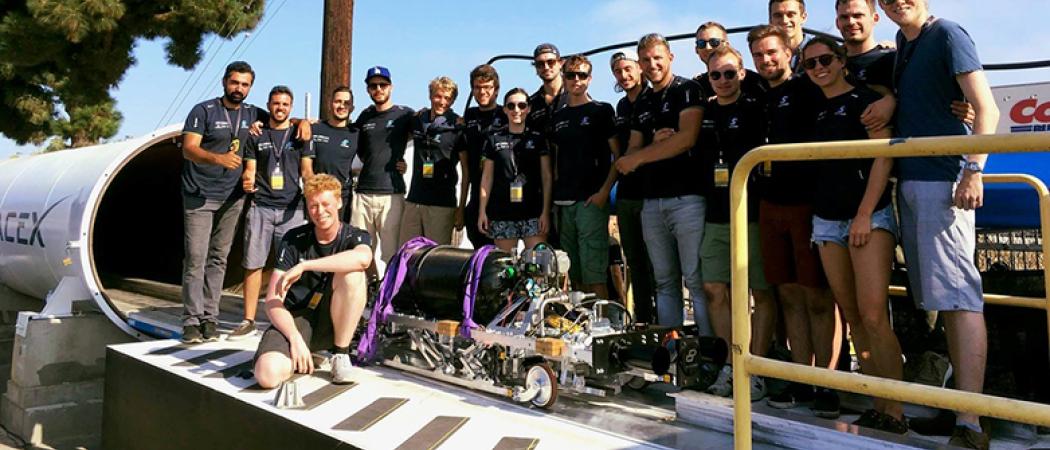
On 22 July, the best student teams from all over the world will take part in Elon Musk’s Hyperloop Pod Competition in Los Angeles. Swissloop, an association of students from ETH Zurich and other Swiss universities, will be there again – with a new transport capsule. The students aim to use Hyperloop technology to transport goods more quickly and in a more eco-friendly way in the long term.
Over 1,000 student teams from all over the world have applied to take part in Elon Musk's third Hyperloop Pod Competition on 22 July in Los Angeles. Swissloop, an association of students from ETH Zurich and other Swiss universities, is one of 20 teams to have received an invitation to Los Angeles. This is the second time that Swissloop has qualified for the competition.
SpaceX founder, Musk wants to use the competition to advance the Hyperloop vision, i.e., that one day capsules will transport people and goods from A to B via vacuum tubes at almost the speed of sound. The teams presenting the most promising concepts will have the opportunity to test their transport capsules – known as “pods” – for a week on the SpaceX site. Only the three best pods will travel through the 1.25-kilometre long vacuum tube on 22 July, the fastest one will win.
After “Escher” comes “Mujinga”
In the summer of 2017, Swissloop made it to the vacuum tube when its first prototype called “Escher” placed third. The students have developed a completely new transport capsule for this year's competition: a three-and-a-half metre long white and blue pod called “Mujinga”. The students presented it to the public for the first time this evening on a 150-metre long test track in the Innovation Park Zurich. This year’s transport capsule is powered by four electric motors. Together they generate over 540 PS, approximately two-and-a-half times the capacity of a Bugatti motorcycle. The energy comes from two batteries providing a total of 700 volts and a capacity in excess of 1,500 iPhone batteries. The new pod is named after the Swiss athlete Mujinga Kambundji. She is Switzerland’s
fastest woman sprinter ever with a time of 11.07 seconds for 100 metres. The funding for the “Mujinga” hyperloop pod came primarily from the industrial sector, as was the case with “Escher”.
“We learnt a great deal this year and we were able to test all our subsystems in advance, unlike last year”, says Ilyas Besler, ETH Zurich student and Lead Technical of Swissloop. “Our interdisciplinary team, ETH know-how and the collaboration with the industry are our recipe for success. We are very much looking forward to Los Angeles, but our long-term goal goes well beyond this competition.”
Faster and more eco-friendly transport of goods
The students aim to use Hyperloop technology to revolutionise the transport of goods over the long
term. “Online customers expect faster delivery of their goods all the time, ideally within a few hours. As companies strive to fulfil these expectations, more and more logistic centres are being built in the vicinity of large Swiss cities. It also leads to half-filled delivery vans clogging up the roads and harming the environment,” explains Luca Di Tizio, ETH Zurich student and member of the board of Swissloop. “We aim to help solve these problems.”
Swissloop’s vision of the future includes packages transported a lot faster and in a more eco-friendly way via a type of modern pneumatic tube. This will be achieved via a nationwide underground Hyperloop system. Pneumatic tubes with a diameter of roughly one metre will connect a central logistics warehouse with major urban conurbations. Transport capsules could carry packages through this network and reach their destination in a matter of minutes. Drones, bicycle couriers or electric cars, for example, could then take the packages on the final leg of the journey to the recipient's post box. “We need industry cooperation to move our vision forward. We are already in contact with some potential partners”, says Di Tizio.
This release was first published 22 May 2018 by ETH Zurich.





 A unique international forum for public research organisations and companies to connect their external engagement with strategic interests around their R&D system.
A unique international forum for public research organisations and companies to connect their external engagement with strategic interests around their R&D system.